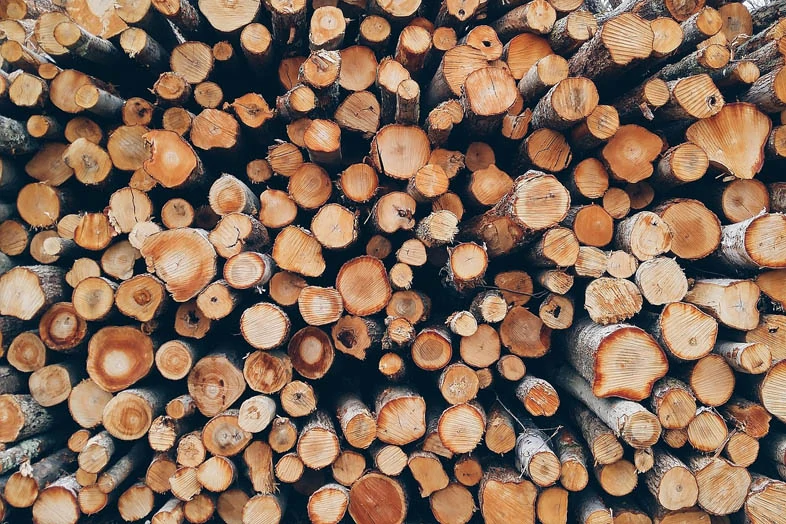
Starting a hobby that uses greenwood is rewarding, however, it can be confusing for a novice. From understanding its unique properties to sourcing it sustainably, there’s much to learn. Dive into my guide on “Sourcing, Storing, and Working with Greenwood” to unlock the essentials of this engaging craft.
What is Greenwood?
So, what is greenwood? Simply put, is wood that has been freshly cut and still contains moisture. Unlike seasoned or dried wood, which has been allowed to dry out over time, greenwood retains the natural sap and moisture content of the tree it was cut from. This characteristic can make greenwood more malleable and easier to work with for certain woodworking projects, especially those involving carving or turning.
Where Can You Source Greenwood?
Greenwood can be sourced from a variety of places:
- Local Timber Yards or Sawmills: These places often have a supply of fresh cuts. Make sure to specify that you’re looking for greenwood as they might also have seasoned wood on offer.
- Tree Services or Arborists: They often cut down trees or trim branches and might be willing to provide or sell you some greenwood. I’m lucky my woodworking group at Burwash Manor in Cambridgeshire has access to a tree surgeon’s wood pile.
- Forest or Woodland Management Teams: They might conduct controlled felling and could be a source of fresh timber.
- DIY Approach: If you have access to woodland and the necessary permissions, you can fell your own trees. However, it’s essential to ensure you’re using safe and appropriate methods and adhering to sustainable practices.
Always remember to source wood sustainably. Overharvesting can harm ecosystems, so ensuring that any timber you procure comes from a responsible source is essential.
How Best to Store Greenwood?
Storing greenwood correctly is vital to maintain its workability and prevent it from drying out too quickly, which can lead to cracking. Here are some effective storage methods:
- Keep it in a Cool, Shaded Place: Direct sunlight and wind can speed up the drying process. Store greenwood logs or planks in a shaded and cool area to slow down the drying.
- Seal the Ends: The ends of greenwood logs are where most drying occurs, leading to potential cracking. You can significantly reduce this risk by sealing the ends with a wax-based product or even latex paint.
- Store it Off the Ground: Use wooden pallets or other platforms to elevate the wood off the ground. This ensures better air circulation and reduces the risk of the wood absorbing moisture from the ground.
- Wrap in Plastic: For smaller pieces or short-term storage, wrapping the greenwood in plastic can help retain moisture. However, be cautious, as this can also promote mould growth if the wood is kept wrapped for an extended period.
- Monitor the Moisture Content: If you’re a seasoned woodworker, consider using a moisture metre. This device can give you an idea of the wood’s moisture content and guide you on when it’s ideal for working.
Why Use Greenwood in Crafts?
Greenwood, in its essence, offers a unique charm and flexibility that seasoned wood might not always provide. But what makes it particularly attractive for crafting? Let’s delve into the reasons:
- Malleability: Greenwood is easier to carve and shape due to its retained moisture content. This softness is a boon for artisans such as pole-lathe bowl turners and spoon carvers.
- Authenticity: Crafts made from greenwood carry a raw, authentic charm, often showcasing the natural grain and hues of the timber, making each piece distinct and unique.
- Economic Benefits: Greenwood can often be sourced at a lesser cost than seasoned wood, especially if you’re obtaining it locally or directly from tree services.
- Environmentally Friendly: When sourced responsibly, greenwood crafts can have a smaller carbon footprint compared to crafts made from imported or extensively processed woods
- Shorter Waiting Time: Unlike seasoned wood, which requires a waiting period to dry and mature, greenwood can be used almost immediately after sourcing, making it a favorite for spontaneous projects.
Incorporating greenwood into your crafting endeavors not only adds a touch of authenticity to your creations but also offers a sustainable and versatile medium to work with. As with any material, understanding its characteristics is key, and with greenwood, the rewards can be both beautiful and fulfilling.
In conclusion, greenwood offers unique benefits for various woodworking projects. By sourcing it responsibly and storing it correctly, you can take advantage of this versatile material while practising sustainable woodworking.
